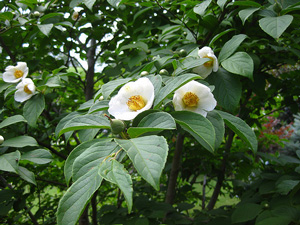Resource Library
Plant of the Week: Korean stewartia
The University of Arkansas System Division of Agriculture does not promote, support or recommend plants featured in "Plant of the Week." Please consult your local Extension office for plants suitable for your region.
Plant of the Week
Korean stewartia
Latin: Stewartia koreana

Trees, instead of the quickly withering basket of funeral flowers, make wonderful memorials to serve as a remembrance for a life well lived. On the occasion of my father’s passing in 2000, friends and co-workers presented me with a tree to mark the event. The tree, a Korean stewartia (Stewartia koreana), has prospered in my shade garden and will outlive my father’s fourth son to become a thing of beauty and inspiration long after the reason for its planting is forgotten.
Twenty species of stewartia are described in the botanical literature with only two found in the Eastern United States. The rest hail from temperate and tropical Asia. They belong to the tea family and mostly grow as small pyramidal trees in the 20- to 30-foot range. The most common stewartia in cultivation, and even it is rarely seen, is S. pseudocamellia from Japan. Because the Japanese and Korean stewartias are so similar, some botanists list the Korean species as a variety of the Japanese species while others simply lumped them into the Japanese species without distinct recognition.
My stewartia has alternate, 3-inch long leaves with serrate margins. In the fall, the leaves turn a beautiful orange-red to yellow-orange, depending on the season. Mature trees have beautiful exfoliating trunks that are often in shades of gray, brown and orange. At about 10 years of age, my tree began to peel and is giving a hint of what the future holds as the tree ages.
The pure white flowers appear in June and are 3 inches across. Each flower has five silky white petals surrounding a dense cluster of yellow stamens. The flowers persist only a day or two and then fall to the ground where they make a magical carpet beneath the tree. While individual blossoms are short-lived, the tree remains in bloom for about three weeks.
My Korean stewartia has done remarkably well in my north-facing Arkansas garden that has a covered canopy of post oaks. Stewartias have a reputation for being difficult to transplant and hard to grow, but my tree has prospered in the dry shade and is now about 12 feet tall with a 4-inch trunk. While this may be a slow growth rate for a shade tree, I’m well pleased by the steady growth and undemanding character of the tree.
American nurserymen swear to the fact that the Korean stewartia is the most drought- and heat-tolerant of the stewartias. While botanists might be correct in combining this in with the more common Japanese species for naming purposes, the Korean form seems to be a more adaptable eocotype that makes it a better garden plant than others of its kin. Though it is not positively known, most of the Korean stewartias in cultivation seem to have originated as seedlings from plants E.H. Wilson introduced to the Arnold Arboretum in 1917.
This stewartia is hardy from zone 5 through 8 and is best sited in high shade or in an area that gets shade in the afternoon during the hottest part of the day. It does best in slightly acidic, highly organic soils that are uniformly moist. My tree though has always been on the dry side during the summer months and the soil is decidedly higher in clay content and lower in organic matter than is recommended. Much of my success with the tree may be because my garden faces north and does not have to endure the summertime baking of sites facing south or west.
Stewartias make an excellent specimen tree that will only become more beautiful as time progresses. It makes an ideal specimen near patio, deck or entryway locations.
By: Gerald Klingaman, retired
Retired Extension Horticulturist - Ornamentals
Extension News - July 6, 2012
The University of Arkansas System Division of Agriculture does not maintain lists of retail outlets where these plants can be purchased. Please check your local nursery or other retail outlets to ask about the availability of these plants for your growing area.